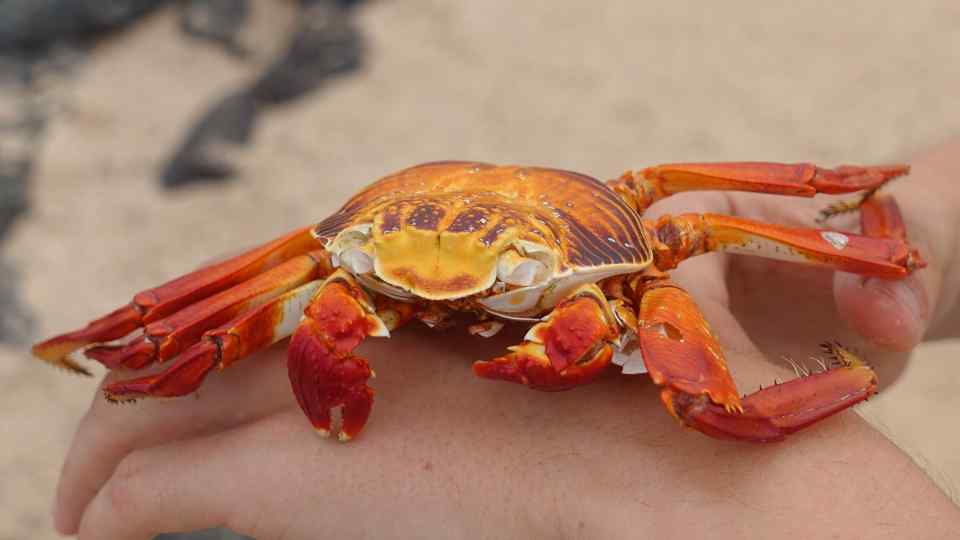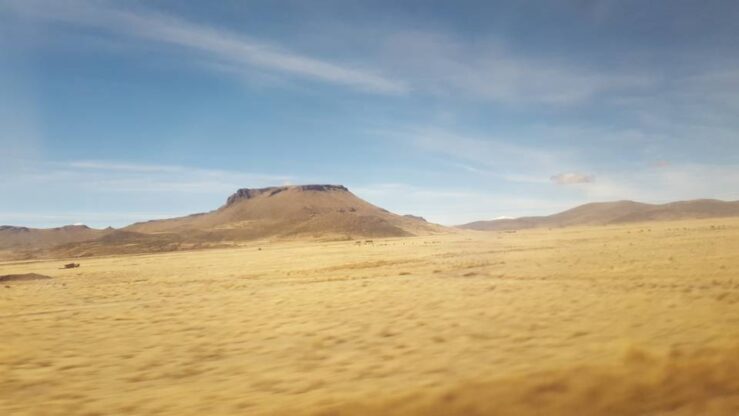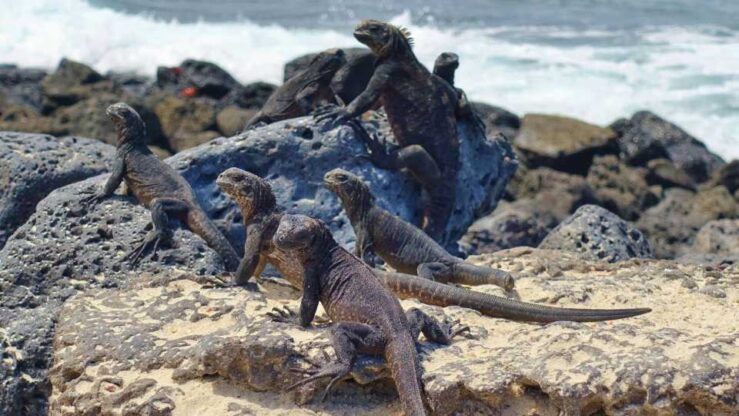Meet the Sally Lightfoot Crab, Galapagos Iguanas, Frigate Birds & Sea Lions…
Santa Cruz Fish Market is a most lively place. In addition to the fish on the counter, the place abounds with interesting animals, including species from the glistening sea lions, the black Galapagos iguanas and elegant frigate birds to the fast, red Sally Lightfoot crab. A couple of pelicans and herons fight for attention, waddle across the market floor and line up, begging behind the central counter. They are waiting for scraps and even attempt to steal whenever possible.
One of the handsome Galapagos iguanas rests in the background on the pier. It remains for a long time as motionless as a statue. If you didn’t know better, you could mistakenly believe it was dead, but it certainly isn’t! Galapagos iguanas don’t move much during the day.
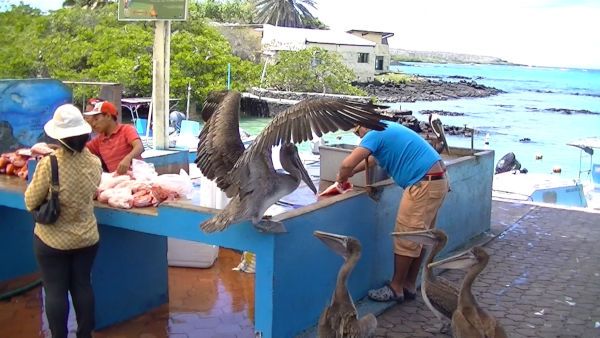
Life at Santa Cruz Fish Market | Photo: Travel In Culture
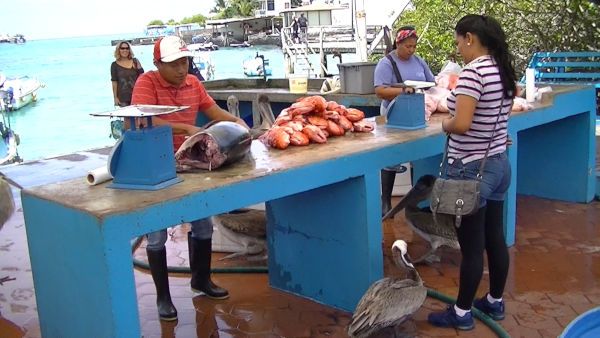
Orange scorpion fish and yellowfin tuna | Photo: Travel In Culture
You can stay entertained for a long time, watching the birds soar into the air after being fed with bits of fish trimmings. The orange and red Sally Lightfoot crabs emerge now and then unexpectedly from their hideouts in between the rocks. It is indeed a fantastic place for photography.
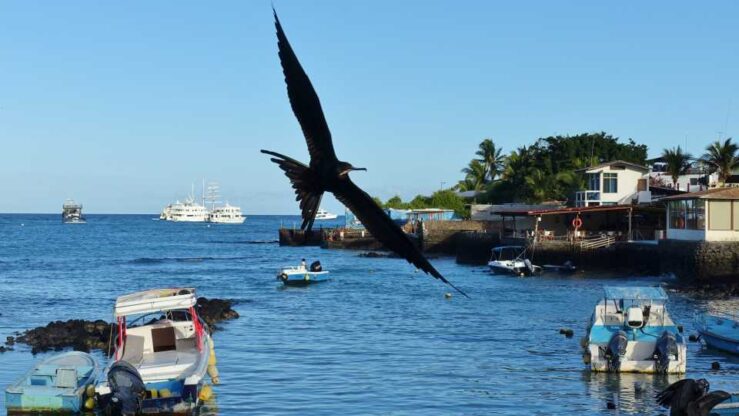
Photo: Travel In Culture
The male frigate birds have a characteristic patch of red skin on the throat called a gular sac. Most of the year, it is barely visible. During the breeding season, it inflates the pouch to attract the female birds. It is a beautiful bird that lives across subtropical and tropical oceans. To steer, it uses its deeply forked tail.
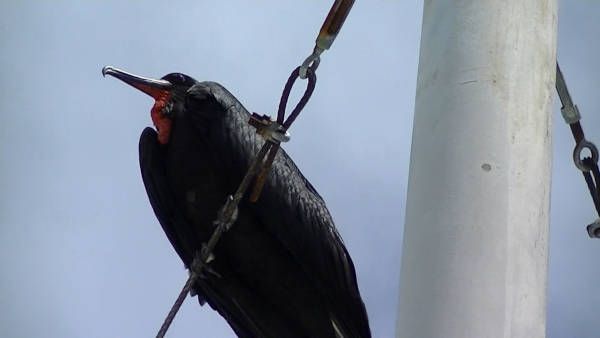
Photo: Travel In Culture
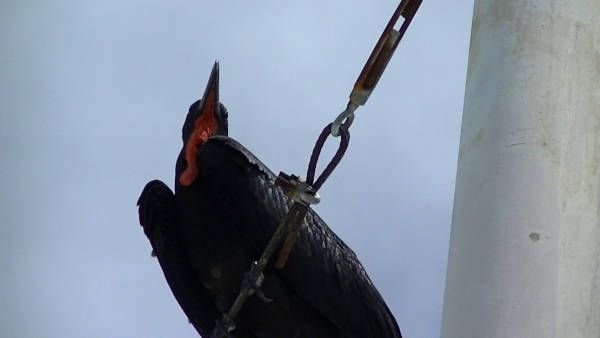
Frigate bird | Photo: Travel In Culture
Two sea lions lie lazily on the other side of the counter, not paying attention to the crowd watching. A third one looks ready to snatch a bite of fish or handouts from the workers, gutting and weighing the freshly caught yellowfin tuna and colourful scorpion fish, locally known as brujo. Locals come here to purchase fish to cook at home for dinner or to serve in their restaurants. Tourists going for a stroll stop at the sight of the pile of brujos and lobsters in plastic boxes.
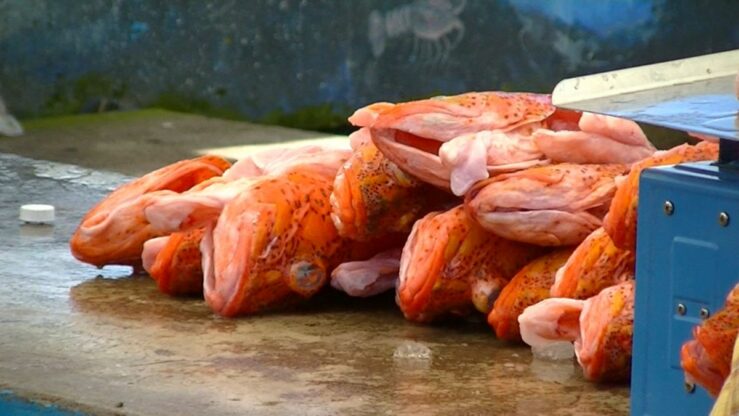
Photo: Travel In Culture
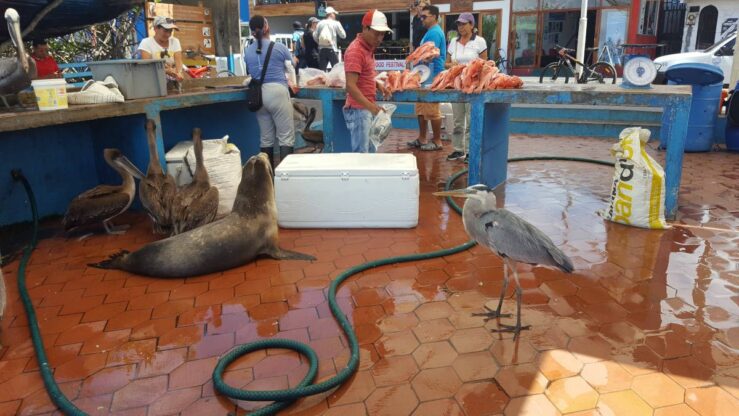
The locals at Santa Cruz Fish Market | Photo: Travel In Culture
You need to watch your steps here. Keeping the required distance of 2 metres (6 feet) to the huge birds and sea lions is one thing. Another is to avoid stepping on lava lizards or marine iguanas, ubiquitous along the waterfront.
A couple of fishermen have made themselves comfortable and rest in their boat after bringing their catch ashore. They don’t seem in a hurry and chat with the fishermen in other boats moored in the small harbour. Soon, a sea lion appears from the water and hangs out just beside them, checking if there is freshly caught fish to go for.
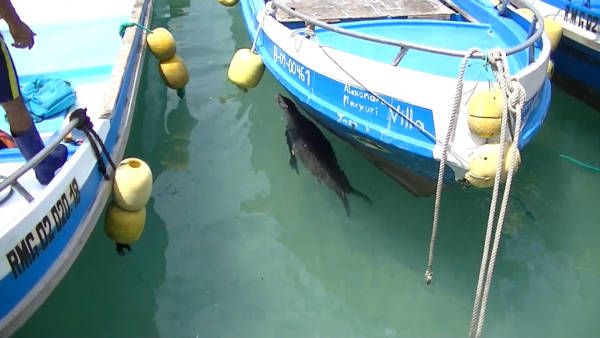
Photo: Travel In Culture
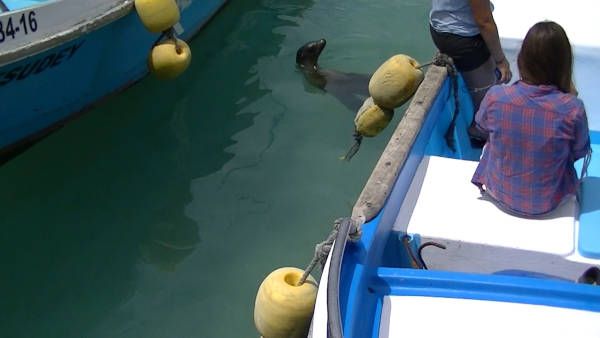
Photo: Travel In Culture
Further away, two eagle rays glide underwater near the surface. Their sharp contours and characteristic spotted patterns are visible in the clear and calm water. All of a sudden, one of the rays jumps out of the water with a gigantic splash.
Road safety Ecuador/your country
McMeal price Ecuador/your country
Crime rate Ecuador/your country
On another small pier along the waterfront, a couple of black Galapagos iguanas, also known as marine iguanas, hang out surrounded by impressive, red Sally Lightfoot crabs. The elegant crabs dot the shore everywhere on the archipelago. When someone approaches, the Sally Lightfoot crabs immediately spurt away and hide between the rocks.
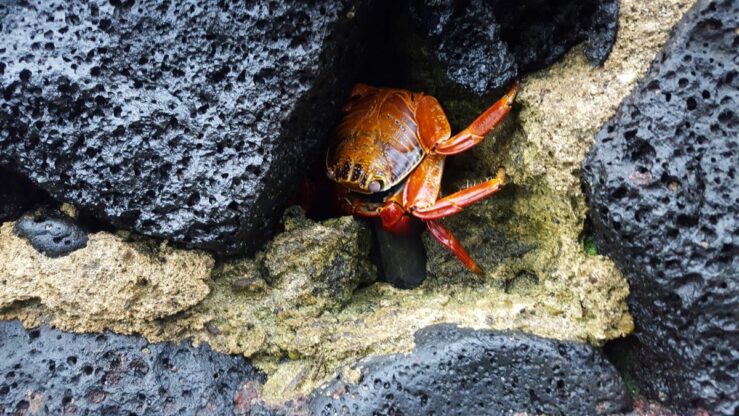
An elegant Sally Lightfoot crab hiding | Photo: Travel In Culture
All of a sudden, a boy shouts in a voice full of excitement: ‘Señor, señor, tortuga!’ and points at the sea bottom. At first, nothing special can be seen on the greyish and rocky bottom. But then, suddenly, some of the rocks seem to set in motion. It is a giant sea turtle moving around all close in shallow water. And then, it gently raises its tiny head and slowly begins to swim towards the surface.
The sea turtle swims majestically near the small pier, and then, finally, the head pops up above sea level. A sea turtle can stay for a relatively long time underwater, holding its breath, sometimes up to several hours, but eventually, it needs to come up to breathe.
People assemble on the pier to watch this wonder of a sea turtle. If something can unite both locals and tourists, it is the fascinating animals. The locals are eager to share their knowledge about the creatures and how to get the best chance to observe them. It is easy to find yourself in a spontaneous conversation with people you would probably never have addressed otherwise. People here are amiable and outgoing, so it is easy to get information about marine life!
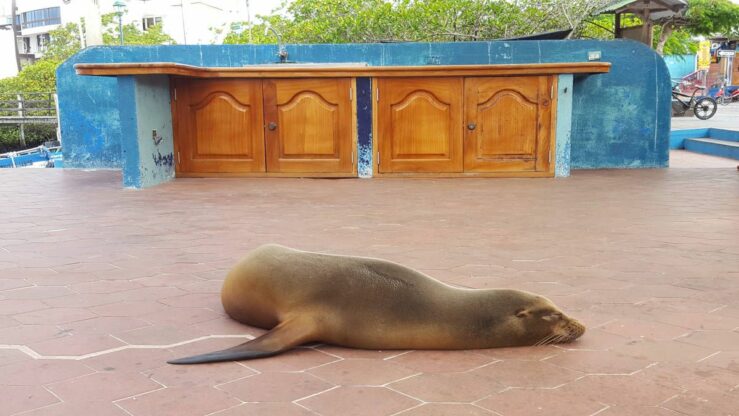
Sea lion at Santa Cruz Fish Market | Photo: Travel In Culture
Continuing along the waterfront, you will reach Charles Darwin Research Station. It was inaugurated in 1964 and is a centre for the study and conservation of species endemic to the Galapagos Islands. There are programmes here for both endangered animals and plants.
Young giant tortoises are hatched and raised through a breeding programme that aims to release them into the wild when they grow up. The programme has proved helpful in augmenting the number of threatened giants on the islands. Walking around the Research Station lets us see the baby tortoises at various ages. You can learn about the variations of the species that inspired Darwin to his theory of evolution and made the archipelago renowned worldwide.
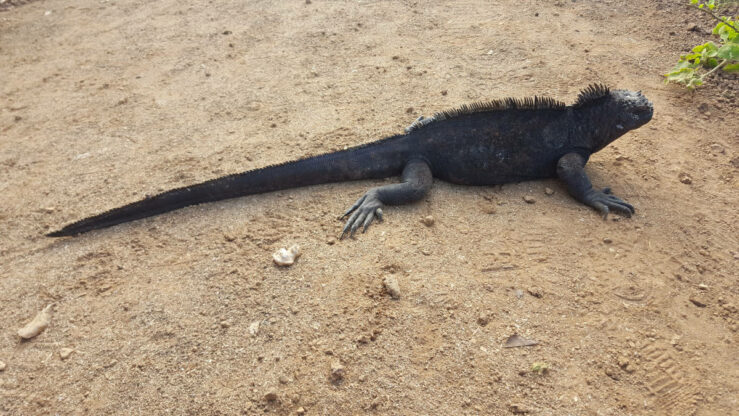
A black Galapagos iguana blocks the path | Photo: Travel In Culture
Outside, there is a group of Galapagos iguanas sitting on the path. One poses for a photo! Another more energetic individual fights his way through the terrain. However, the movements of the Galapagos iguanas are slow on land due to their compact and heavy bodies. The impressive iguanas are among the laziest reptiles in the Galapagos Islands – the iguana can sometimes appear dead, but it isn’t!
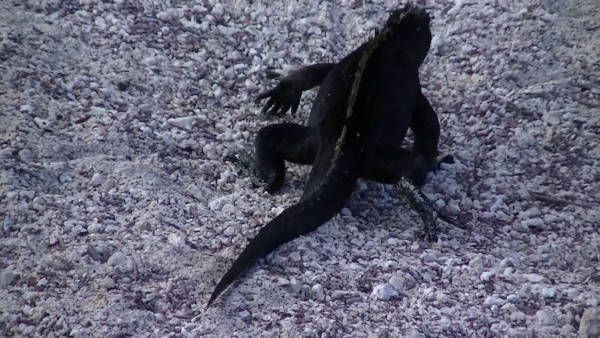
Photo: Travel In Culture
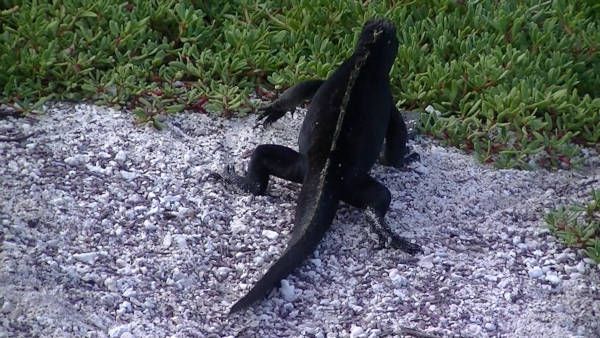
Photo: Travel In Culture
Read next: Explore the Mythic Inca Culture on Machu Picchu and Sacred Valley Peru, Maras, Moray and Inca Ruins in Pisac
Find useful travel gear: Travel Essentials
‘Meet the Galapagos Iguanas, Sally Lightfoot Crab…’
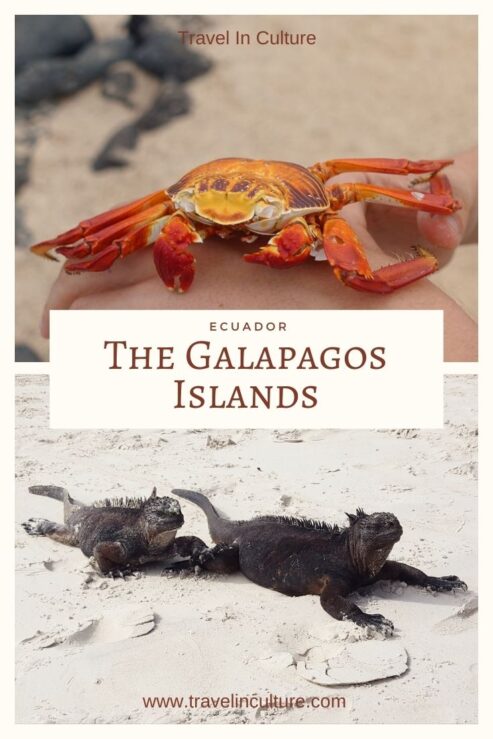
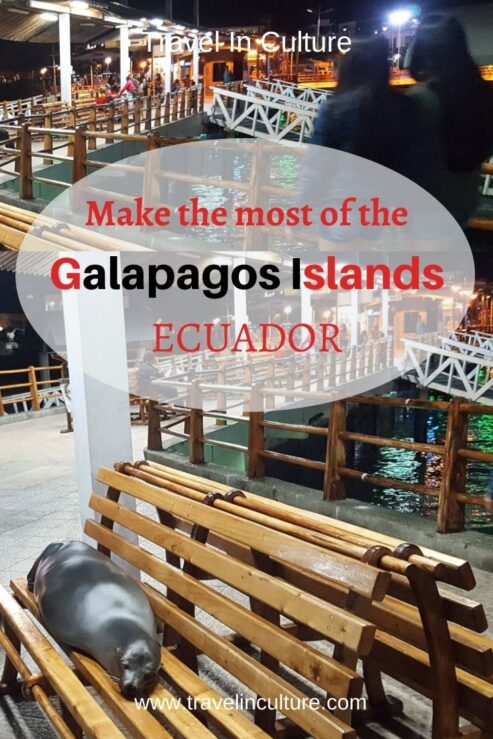
Featured image of
Meet the Galapagos Iguanas, Sally Lightfoot Crab & Sea Lions:
Travel In Culture


